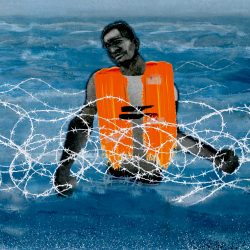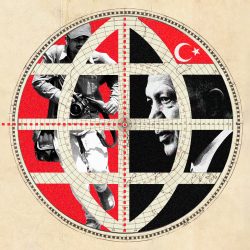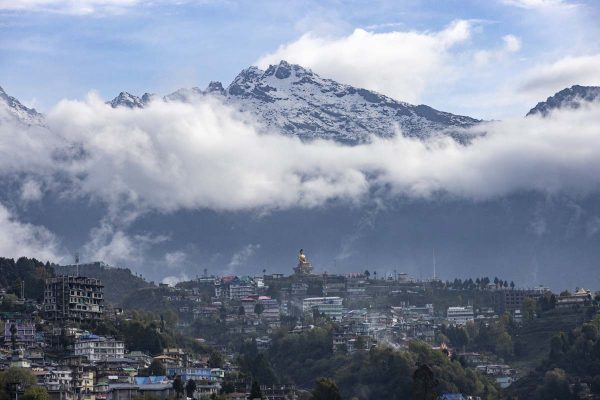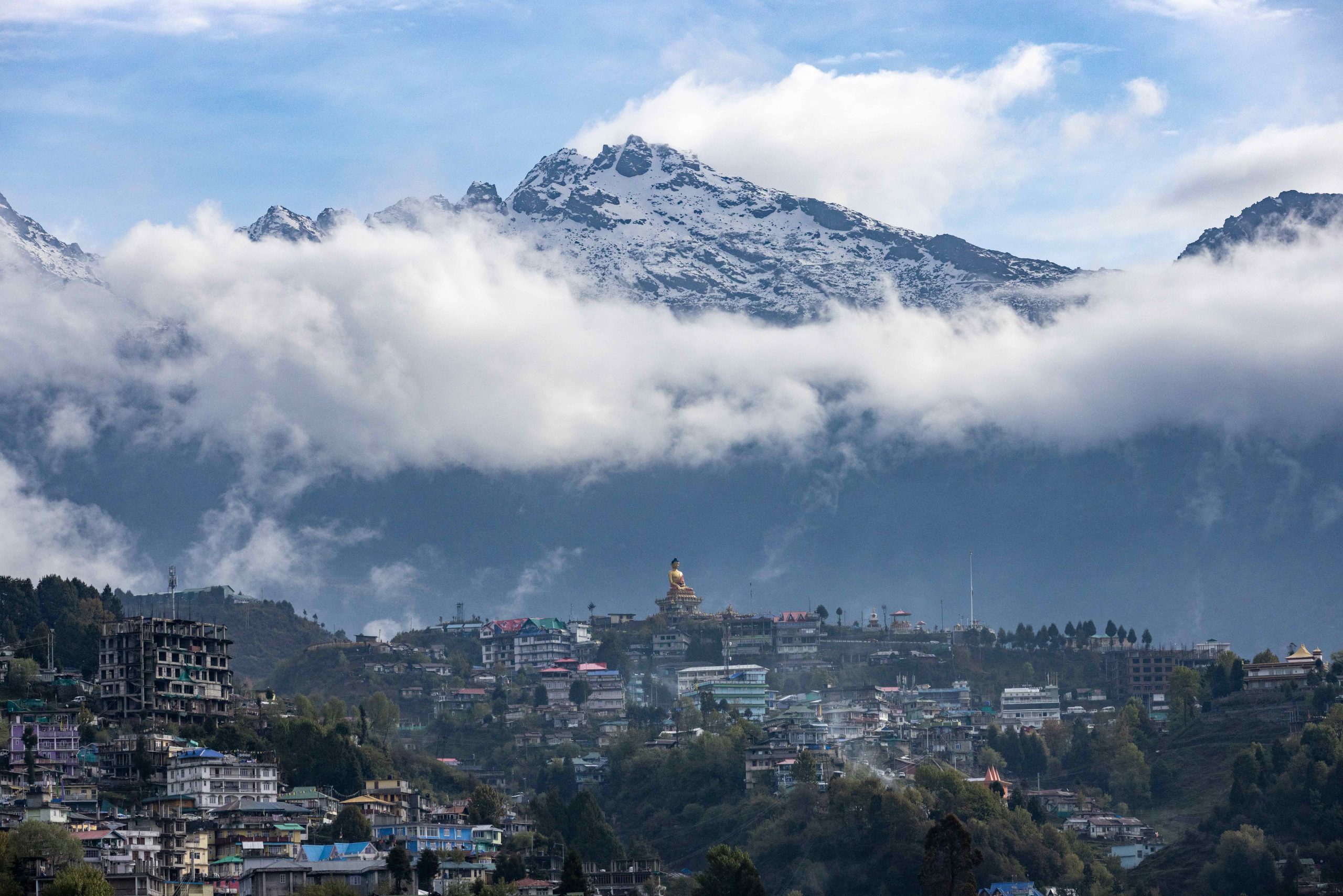
India and China draw a line in the snow
- By Shougat Dasgupta
- Photography by Ishan Tankha
- feature
“People here, local people, just don't take it very seriously,” said Jambey Wangdi as he sipped on some fresh watermelon juice in a hotel in Tawang, a town in the state of Arunachal Pradesh that sits on India’s jagged eastern Himalayan border with China. He punctuated these words with a phlegmatic shrug. I had asked him how Arunachali people feel about being on the frontline of an intense, intractable and very current border dispute between two nuclear powers.
The Big Idea: Shifting Borders
Borders are liminal, notional spaces made more unstable by unparalleled migration, geopolitical ambition and the use of technology to transcend and, conversely, reinforce borders. Perhaps the most urgent contemporary question is how we now imagine and conceptualize boundaries. And, as a result, how we think about community.
In this special issue are stories of postcolonial maps, of dissidents tracked in places of refuge, of migrants whose bodies become the borderline, and of frontier management outsourced by rich countries to much poorer ones.
On June 21, Indian Prime Minister Narendra Modi began a four-day “state visit” to the United States — an event that is slightly more ceremonial than an “official” visit and an honor typically reserved for close allies. High on the agenda will be both countries’ strategic need to counter China’s economic and military might and its regional assertiveness. India is being talked up by the Biden administration as the “cornerstone of a free, open Indo-Pacific.” But as the U.S. and India grow closer, the latter’s diplomatic relations with China have nosedived. “This is the worst time I’ve seen in my living memory in I-C relations,” tweeted Nirupama Menon Rao, the former Indian ambassador to both China and the United States. “And I’m not exaggerating. It’s serious.”
On the eve of his visit to the U.S., Modi told the Wall Street Journal in a rare interview, that for “normal bilateral ties with China, peace and tranquility in the border areas is essential.” Last month, I traveled to Tawang, which sits 10,000 feet above sea level and about 20 miles from Bum La Pass, the border post between India and Chinese-occupied Tibet. China has long claimed Tawang, a center of Tibetan Buddhism, as rightfully Chinese. I met Wangdi at a ritzy resort on the city’s outskirts. A high-ranking functionary in the Arunachal Pradesh government, he was keen to impress upon me the patriotism of people in the state. “Physically we may look a bit different, the shape of our eyes may be different,” he told me. “But emotionally, mentally, we really consider ourselves to be true Indians.”
According to Wangdi, the Indian government’s focus on improving infrastructure in the northeast of the country means that Arunachal Pradesh and Tawang in particular are booming. As I drove up to Tawang from the plains on freshly paved roads, evidence was everywhere. Unfinished construction, scattered outcroppings of concrete mushrooms, marred the mountainscape.
Even the hotel in which we sat was still only half-built. The yet-to-be-installed picture windows in yet-to-be-finished rooms will look out on a famous 17th century Buddhist monastery. Future guests will also see the 30-foot high gilded Buddha that towers over Tawang, a giant looking down on Lilliput.
It was an overcast day in the middle of May when we spoke, the air heavy with the promise of rain. Wangdi leaned back in his chair, every inch the local grandee, self-assured and hospitable. “As far as tourism potential goes,” he told me, “Tawang is at the very top.”
He says the speed and purpose with which Modi’s government is developing Arunachal Pradesh, gradually making the state accessible by air, rail and road, is guaranteed to create economic opportunities and to match the impressive progress on China’s side of the border. Oken Tayeng, a successful tour operator, told me that Arunachal Pradesh was now “at a crucial threshold.” The state, he said, “can still decide the kind of tourists it wants to attract.” He cites neighboring Bhutan as a model for “how to bring in high-quality tourists with little environmental impact.”
But Tawang is not there yet. The rampant building spree appears ad hoc and unregulated amidst the coniferous hills and cascading waterfalls. Wandering through the center of Tawang — its shabby streets similar to those in dozens of other small Indian hill towns, with tourists from Bengal, Gujarat and Maharashtra haggling with vendors in Hindi — it is hard to understand why China believes that most of Arunachal Pradesh, and certainly all of Tawang, is theirs.

India’s traditional neighboring rival has been Pakistan. But it is India’s burgeoning rivalry with China that preoccupies security analysts, as the two Asian behemoths, particularly over the last three years, have become embroiled in a bitter, and at times violent, standoff along their 2,100-mile border. Neither country appears willing to take a step back or disengage.
Though Tawang has been administered by independent India for 72 years now, China maintains that the town is culturally and historically a part of Tibet and therefore Chinese territory. Since 2020, China is estimated to have occupied almost 1,000 square miles of previously Indian-controlled territory in border regions. Satellite images show Chinese-built bridges, roads and watchtowers stretching several miles into what was commonly considered the Indian side of the so-called “Line of Actual Control.”
Prime Minister Modi has vociferously denied any concession of territory to China. In June 2020, Indian and Chinese soldiers fought in the western Himalayan region of Ladakh, in the Galwan Valley. Twenty Indian soldiers were killed in hand-to-hand combat. They “have been martyred,” said Modi at the time. “But those who dared Bharat Mata (Mother India), they have been taught a lesson.” Such was the current strength of the Indian army, he added, that “no one can eye even one inch of territory.”
China did not officially disclose any casualties. It was the first loss of life for Indian and Chinese troops on the border since 1975. Another brawl broke out in the final weeks of 2022. On December 9, hundreds of Chinese and Indian troops faced off on the border near Tawang. Indian Defense Minister Rajnath Singh told the Indian Parliament that at least 300 Chinese soldiers had tried to cross over into territory held by India. The troops engaged briefly, with their fists and improvised weapons. Six Indian soldiers were reported to have been treated for minor injuries. To prevent fistfights from turning into firefights, India and China have had agreements in place for decades, committing not to use live firearms within a mile or so of the border. But both sides have now deployed arms, and as many as 60,000 troops each, to the border. The situation is “fragile and dangerous,” India’s External Affairs Minister S. Jaishankar told the press.
Ashok Kantha, a former Indian ambassador to China, says that China has been “pushing the envelope” on border issues with India for over a decade now, seeing what it can get away with. These “gray zone” maneuvers, falling just short of a declaration of war, he told me, are “typical of China’s pressure tactics and intended to make India pay a heavy price for border management.” Kantha, who now directs the Institute of Chinese Studies in New Delhi, was referring to the exorbitant costs incurred by India to keep additional troops in harsh and remote terrain all year round and the costs of building the infrastructure to prevent what he called China’s “salami-slicing” method of incrementally expanding its territorial claims.
Writing for The Caravan, an Indian English-language magazine, last October, Sushant Singh, a fellow at the Delhi-based Center for Policy Research, pointed out that “perceived signs of weakness vis-a-vis Pakistan and China are anathema to Modi’s strongman image.” So the Modi government, Singh added, has adopted the “undemocratic domestic strategy of keeping the Indian public in the dark” by restricting “access to journalists and blocking questions and discussions in parliament.”
Instead, the government and the pliant mainstream media have chosen to hype Modi’s “friendship” with Chinese President Xi Jinping. In 2014, when Modi became prime minister, the two famously sat together on a gaudy ceremonial swing in Modi’s home state of Gujarat.

“Modi’s personalized diplomacy with Xi,” Singh wrote, “has been an abysmal failure.” Over the phone, Singh told me that despite Modi’s posturing about India’s status as a leading global power and Modi’s own status as a charismatic global statesman, the prime minister is fearful of escalating tensions with China.
It is an uncharacteristic diffidence. In February, India’s foreign minister metaphorically hoisted a white flag when questioned about border disputes with China. “As a smaller economy,” Jaishankar said, “what am I going to do, pick a fight with a bigger economy?” It was a discomfiting echo, from a key Indian cabinet minister, of the official Chinese contempt for India’s pretensions. “China,” Ashok Kantha told me, “sees its relationship with India through the prism of its larger rivalry with the United States.”
Sushant Singh put it more bluntly. “China,” he said, “figures very highly in the Indian imagination. India hardly figures in the Chinese imagination.”

In the Chinese understanding of the global hierarchy, Singh told me, “India is too weak to be granted agency in its own right.” Instead, China thinks of its relations with India as a subplot to the main narrative: China plans to become the world’s preeminent power by 2049. As if to back up this reading, a major security conference held in Singapore in early June was dominated by talk of the rivalry between China and the United States. “A confrontation” between the two superpowers, said the Chinese defense minister, “would be an unbearable disaster for the world.”
Talk of India, meanwhile, was relegated to a footnote. A Chinese colonel told journalists that India was “unlikely to catch up to China in the coming decades because of its weak industrial infrastructure.” In a dismissive aside, he asked: “When you look at the Indian military’s weapon systems, what types of tanks, aircraft and warships were made and developed by Indians themselves?” The answer is: none.
China’s confidence that it has the upper hand in its relationship with India is bolstered by the numbers. Its economy is nearly six times the size of India’s, and China spends about $225 billion on defense compared to India’s $72 billion.
It is India’s urgency in improving infrastructure in its border areas, in connecting once-isolated states like Arunachal Pradesh to the rest of the country, that accounts in part for China’s increased belligerence, Ashok Kantha told me. Back in Tawang, the construction equipment I saw strewn everywhere, the roads being scoured into the hills and the soldiers who outnumbered the tourists all told the story of India’s attempts to catch up to China.

Sushant Singh traces this development back to 2006, when the influential Indian foreign secretary at the time, Shyam Saran, rejected India’s prevailing strategy of treating its border areas as “buffer zones between China and the Indian heartland.” It was, Singh told me, “an ‘outpost’ outlook inherited from the British.” Instead, Saran argued that India needed to radically upgrade its capacity along the border. It needed to put down hundreds of miles of new roads, lay railway tracks and build bridges and airports. From India’s perspective, this necessary self-assertion in the border regions has revived arguments that had lain dormant for two decades.
While India and China may have been growing further apart for at least 15 years now, the deadly fight in the Galwan valley in 2020 marked the start of what Indian Foreign Minister Jaishankar has said is “a very challenging and abnormal phase in our ties with China.” In 2022, China introduced a new border security law, which described the territorial sovereignty of China as “sacred and inviolable.” It also made it official state policy to continue to expand and support the construction of villages and towns along border areas.
India, again belatedly reacting to China’s initiative, announced its own “vibrant villages” scheme to build settlements in long-neglected, often poor and desolate border areas. China has reportedly already built some 600 villages in occupied Tibet. It took until 2023 for India to begin building its first “vibrant village” in Arunachal Pradesh. Home Minister Amit Shah visited the state this April to kickstart the program. “Whenever I come to Arunachal,” said Shah, “my heart is filled with patriotism because no one greets people here by saying, ‘namaste,’ they say, ‘Jai Hind’ (long live India) instead.”
A Chinese foreign ministry spokesman responded to Shah’s visit by saying it “violated China’s territorial sovereignty.” It was a reminder that China has no intention of relinquishing its claim to Arunachal Pradesh. While China claims the whole state of Arunachal Pradesh as its own, it is mostly Tawang that it prizes. “Tawang is indispensable to China,” a retired colonel in the Chinese army told the BBC in March 2023. In 2017, a former Chinese diplomat described Tawang as “inalienable from China’s Tibet in terms of cultural background and administrative jurisdiction.” He added that the “boundary question was not created by China or India, so we shouldn’t be inheriting it and letting the ghosts of colonialism continue to haunt our bilateral relations.”

It all started, as have many of the world’s present-day territorial disputes, when the British drew a line.
In 1913, negotiations began in Simla, the summer capital of British India, where administrators would retire to escape the heat of the plains. Attending this summit were representatives of British India, Tibet and the new Republic of China — founded after the revolution in 1911 that ended about 275 years of Qing dynasty rule and 1,000 years of Chinese imperial history. Tibet, much to the chagrin of the Chinese representative, was invited as a quasi-independent state. After 1911, the British considered Tibet to be under Chinese “suzerainty,” meaning that Tibet had limited self-rule.
Negotiations played out over several months. When they came to a close, the British representative, Sir Henry McMahon, had determined where the border lines should be drawn between China and Tibet and between Tibet and British India. But China and Tibet could not agree on their border, nor on the extent or nature of China’s so-called suzerainty over a Tibet chafing for independence.

A document signed by the Tibetans and initialed by Henry McMahon set out the contours of the border line between British India and Tibet, without Chinese agreement — the Chinese delegate walked out of the conference in its final phase. China has since claimed that Tibet, as a Chinese protectorate, had no right to negotiate treaties on its own behalf. The line dividing Tibet and British India, which later became known as the McMahon Line, continues to be the basis of India’s territorial claims.
The Simla conference ended messily in July 1914, as Europe found itself preparing for World War I. For two decades after the conference, the British authorities did nothing to enforce the McMahon Line. Tibet still saw its writ as extending through what was called the Tawang Tract.
By the mid-1930s though, wrote the journalist and historian Neville Maxwell, a British official named Olaf Caroe tried to “doctor and garble the records of the Simla Conference to make them support the assertion that India’s northeastern borderline lay legitimately just where McMahon had tried unsuccessfully to place it.” Maxwell is a controversial figure in India, largely because he blames India and its first prime minister, Jawaharlal Nehru, for forcing China into the month-long Sino-Indian war in 1962 by insisting on the legality of the McMahon Line and refusing to come to an independently negotiated border settlement.
What Maxwell took at face value, the Indian editor Pradip Phanjoubam has written, was that “Tibet was Chinese territory all throughout history,” regardless of what the “Tibetans themselves think on the matter.”
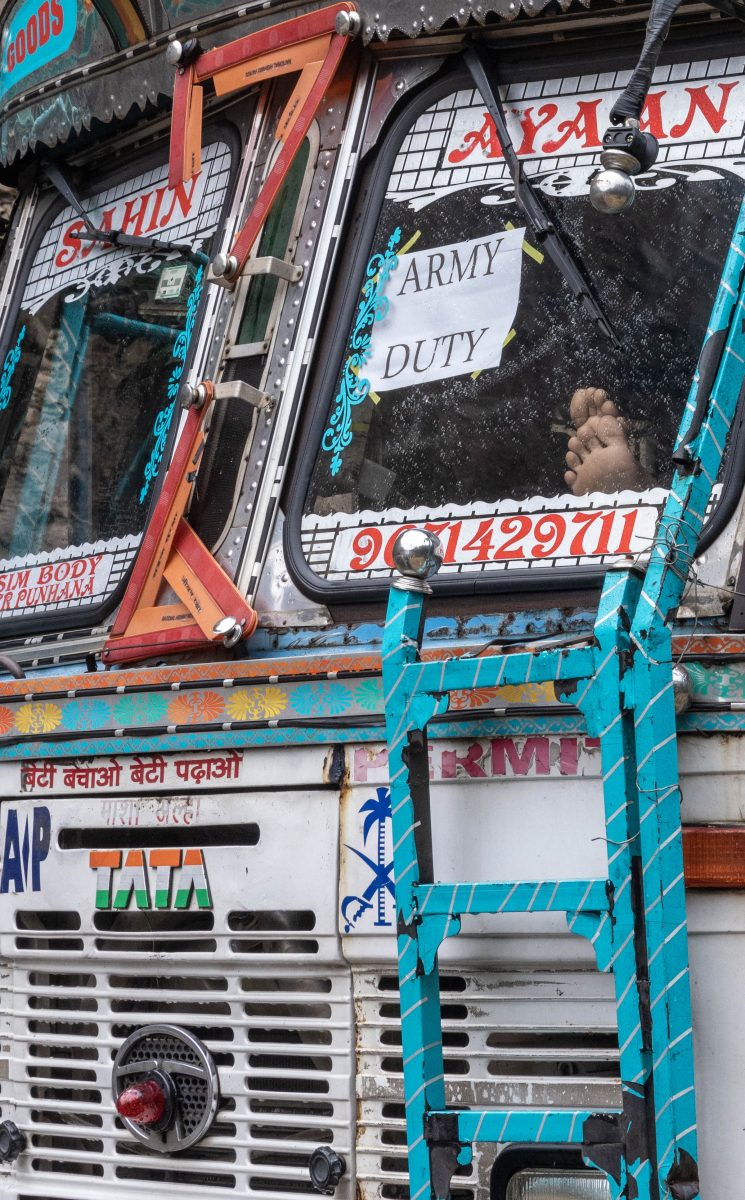
India and China in fact did not share a border until October 1951, when the People’s Republic of China — itself only established by Mao Zedong in 1949 — officially annexed Tibet. The British, despite drawing the McMahon Line, had largely stayed out of Tawang, leaving it to be controlled by Lhasa, the Tibetan capital. But alert to the implications of Chinese aggression in Tibet, India sent an expedition to Tawang led by Major Ralengnao “Bob” Khathing who quickly and efficiently established Indian rule by February 1951.
According to the scholar Sonia Trikha Shukla, Bob Khathing won over residents in Tawang, most of whom were part of the Monpa tribe, with his “tact, firmness and discretion.” He showed, Shukla said, the “benign, enlightened” face of the Indian administration some 37 years after Tawang was supposedly ceded to British India in Simla. China, perhaps preoccupied by the Korean War, didn’t object to India’s takeover of Tawang at the time.
But then, in 1959, there was a popular uprising in Tibet against Chinese control. Fearing arrest and possibly death, the Dalai Lama, the spiritual head of Tibetan Buddhism, escaped over the Tibetan border into Tawang. When I visited the monastery in Tawang, I saw photographs in the tiny museum of a lean, young Dalai Lama wearing a hat at a rakish angle that made him look a little like the gonzo journalist Hunter S. Thompson.
The Dalai Lama, who has lived in India for over 60 years now, set up the Tibetan government-in-exile in Dharamsala in the western Himalayas.
“When the Dalai Lama and his followers fled to India,” wrote historian Jian Chen, an emeritus professor at Cornell University, China became hostile. Two “hitherto friendly countries,” he added, “became bitter adversaries.” According to Chen, when top Chinese leaders discussed Tibet in a Politburo meeting in 1959, Deng Xiaoping — who succeeded Mao in 1976 and transformed China’s economy — said that India was behind the Tibetan rebellion. China believed that the Indian government had allowed the CIA to train Tibetan guerillas on Indian soil, in the Himalayan town of Kalimpong.
India, Mao argued, despite its non-aligned foreign policy, remained a slave to Western interests. “When the time comes,” Chen quotes Mao as saying, “we certainly will settle accounts with them.”
Those accounts were settled in 1962. While the rest of the world was distracted by the Cuban Missile Crisis and the distinct prospect of the Cold War turning hot, a confrontation between India and China over border delimitations was becoming inevitable. Chinese forces crossed into Tawang on October 20, 1962 and overwhelmed the small number of poorly equipped Indian troops on the border. Prime Minister Nehru turned desperately to the United States and Britain for help. But before any international intervention became necessary, China called a unilateral ceasefire.
After a month of territorial gains, China, perhaps concerned about the harsh Himalayan winter, perhaps fearful of American intervention, moved its troops back behind the McMahon Line. While China voluntarily retreated from Tawang and present-day Arunachal Pradesh, it retained control over Aksai Chin, about 15,000 square miles of barely populated, high-altitude desert, territory that India claims but that is of strategic value to China, connecting Tibet to the Uyghur Muslim heartland of Xinjiang.
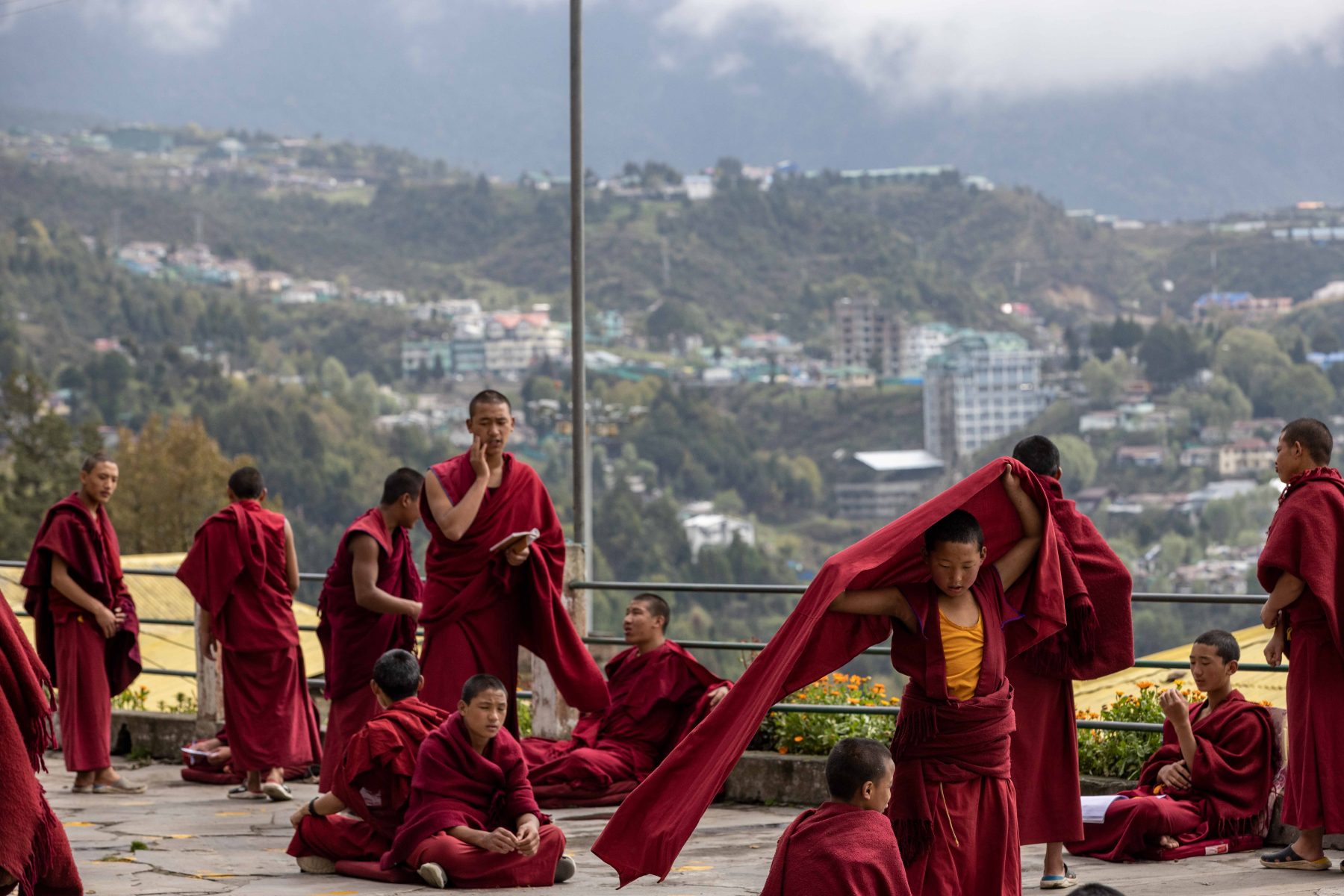
During the 1962 war, thousands of Indians of Chinese descent were removed from their homes and held in internment camps just because of the way they looked, much like Japanese-Americans were incarcerated during World War II. Joy Ma was born in an internment camp in India in 1962. She wrote a book about the 3,000 Chinese-Indians imprisoned in Deoli, in the north Indian state of Rajasthan. I spoke to Ma, who now lives in California, and her co-author Dilip D’Souza on Zoom. Though the war in 1962 lasted only a month, Ma said, many “Chinese-Indians spent up to five years in Deoli Camp.” Some died in the camp. “Some,” she wrote in her book, “were deported to China on ships — a strange and cruel fate to visit on people whose families had been Indian for generations, who spoke only Indian languages and for whom China was a country as foreign as, say, Rwanda might have been.”
Ma told me that she grew up in Calcutta and had lived in India until she went to graduate school in the United States. After the war was over, her family couldn’t bring themselves to speak about what had been done to them. “The government was just so punitive,” Ma said. And, long after the war, even their neighbors would ostracize them. “People didn’t want to know us,” she told me, “didn’t want us to visit.” Ma is among a number of Chinese-Indians, most of whom have emigrated to North America, who are seeking an acknowledgement and an apology from the Indian government.
It’s unlikely to come anytime soon. The war with China looms large in the Indian imagination — for decades after the war, the national tenor was maudlin, mournful, self-pitying but hardly introspective. India positioned itself as a victim rather than any sort of perpetrator. Apart from Ma and D’Souza’s book, there has been no public discussion of the internment of Chinese-Indians or contrition about the destruction of a once-thriving Chinese-Indian community. Only a few hundred Chinese-Indians are left in Calcutta, for instance. Yet every Chinese New Year the media descends on the city to broadcast pictures of dragon dances and celebrate the delicious, hybrid cuisine while resolutely ignoring the jailing of Chinese-Indians in 1962. Over the last three years, as India’s border quarrel with China rose in pitch and intensity, Ma told me, the small Chinese-Indian community has been reminded of its vulnerability and its perpetually provisional status in India.
“The border,” Ma said, “is the reason for our misery.”

The aftershocks of the 1962 war continue to reverberate in India in other ways too. The abject defeat is a stick with which the Bharatiya Janata Party, India’s governing party, still beats Nehru. The war is cited as Exhibit A in the BJP-led prosecution of Nehru’s alleged failings as prime minister. A common trope in the BJP’s narrative is that Nehru was too complacent and too weak-willed to effectively defend India’s borders against Chinese incursions. In December 2022, when Indian and Chinese soldiers brawled on the border near Tawang, the BJP chief minister of Arunachal Pradesh, Pema Khandu, offered some boastful reassurance at a private event. “It’s not 1962 anymore,” he said in Hindi. “It’s 2022 and we’re in the Narendra Modi era.” India could now be relied upon to keep China at bay. And part of how the BJP plans to boost India’s defensive capacities is to invest heavily in Northeast India.
While India prides itself on its linguistic and ethnic diversity, with its pluralism and democratic inclusiveness cited as major weapons in its competition with China, the far less palatable truth is that its union is fractious, riven with conflict and prejudice. In particular, the eight landlocked states of Northeast India, which share borders with China, Myanmar, Bhutan and Bangladesh, have been frequently at odds with the Indian mainstream.
Modi himself tweeted, on March 26, that the “Northeast is witnessing all-round development. Once known for blockades and violence, the region is now known for its development strides.”
A little over a month later, on May 3, Manipur, one of the Northeastern states that Modi was referring to, exploded in ethnic and sectarian violence that has resulted in over 100 deaths. After weeks of silence, the Indian government moved 10,000 soldiers into Manipur to keep the peace. Still, deaths and cases of arson continue to be reported. Internet services have also been largely unavailable since the conflict began and, at the time of publication, had yet to be restored.
Manipur is a powder keg of ethnic resentment at least in part because the BJP’s Hindu-centric approach stirs up communal trouble, in this case between the largely Christian tribes in the hills and the Hindu Meitei people in the valley. In Assam, another state in the Northeast, the BJP’s flawed attempt to build a national register of citizens has left two million people, many of them Muslim, facing statelessness.
Still, in Arunachal Pradesh, it is a common refrain that Modi’s time in power has coincided both with an acceleration in infrastructure building and a renewed commitment to the region. Modi himself has visited Northeast India about 50 times in nine years. The fruits of his personal attention are evident in the recent electoral successes the BJP has enjoyed there: Modi’s party is now the dominant political force in the region.
In the West Kameng district of Arunachal Pradesh, I visited Thembang, an ancient Monpa village that is currently waiting to be awarded UNESCO World Heritage status. On the afternoon I was there, the village was deserted except for some thick-set mountain dogs and a drunk swaying precariously down some stone steps. Despite the poverty of the present-day village, the remnants of massive stone walls and gates betray a more salubrious past. For centuries, Thembang was a “dzong,” a fortified administrative and ecclesiastical hub. Dzongs have been a feature of Buddhist architecture since the 12th century, particularly in Bhutan, which also borders Arunachal Pradesh. They are places of local significance, places of business and bustle, politics and religion.
Walking out of Thembang, I was stopped by Jambay. He only gave me his first name. Obviously prosperous and educated, he spoke fluent English and was eager for conversation with a passing stranger. His family line in Thembang, Jambay said, goes “as far back as it’s possible to go.” But, given the remoteness and relative lack of opportunity in the area, Jambay had been sent to school in Bangalore. He went on to work in the Indian civil service in Delhi. Now, Jambay told me, he had “turned full circle,” returning to his home village to work on a U.N.-sponsored conservation project.
I steered our conversation toward his opinion, as an Arunachali in close proximity to the border, on China’s assertion that Arunachal Pradesh is Chinese territory. Younger people, Jambay said, “know only that they are Indian.” His grandfather’s generation, though, saw themselves as Monpas who were part of a sprawling Tibetan Buddhist land, their cultural totems being the Tawang monastery and the Dalai Lama’s seat in Lhasa. Until 1951, when China annexed Tibet, trade and travel between Lhasa and Tawang — thousands of miles of mountain wilderness traversed on foot and on horseback — was ceaseless, Jambay said.

In 1962, Jambay told me, Chinese troops passed through Thembang on the way to Bomdila, where they battled with the last of the crumbling Indian resistance. The war “was not much discussed” within his family, Jambay said, “because it was so short and most people escaped into Assam before the worst of the fighting.” The few who were “left behind,” Jambay told me, “lived with the Chinese soldiers.” They were “good to the locals,” Jambay said. “Maybe because they wanted to win the people’s hearts.”
But the Chinese soldiers, Jambay said, did not leave a favorable impression. “Indian nationalism flourishes in Arunachal Pradesh,” he told me, “because people resent the Chinese for how they treated the Dalai Lama and are grateful that India gave him refuge.”
But there is, he added, also a new edge in people’s feelings about Nehru and the Congress party, which ruled India for more than 50 of the country’s 75 years as an independent nation. The Congress is now in opposition, a pastiche of the grand party it once was, pitching Nehru’s great-grandson into a losing battle against Modi, who has effectively styled himself as the destroyer of a complacent, English-speaking Indian elite, which clung fast to their inherited privileges.
Jambay says Congress was reluctant to build infrastructure in Arunachal Pradesh because it could also be used by the enemy, whether the Chinese or insurgents from within. “That,” Jambay told me, “is negative thinking, to not want to prepare yourself because you’re so worried about giving your enemy an opportunity.” Some of what Jambay refers to as “step-motherly treatment” is evident in the fact that, until 1972, Arunachal Pradesh was known as the North East Frontier Agency, an unlovely bureaucratic label that suggested that the region only mattered as a buffer between India and China. It took until 1987 for the Indian government to declare Arunachal Pradesh a fully-fledged state.
As for Nehru, Jambay says he “gave up on the Northeast in 1962 when he said, ‘My heart goes out to the people of Assam,’ after the Chinese took over Bomdila.” He is repeating, with conviction, the BJP’s main talkingpoints. The implication is that until the rise of Narendra Modi, the Northeastern states were not treated as fully Indian.

A view of the nearly 30-feet tall Buddha statue that towers over the town of Tawang.
Any Indian visitor to Arunachal Pradesh will invariably remark on two things that appear to separate the state from its Northeastern neighbors. Pretty much everyone in the state speaks Hindi. And Arunachalis wear their patriotism on their sleeves.
Jambey Wangdi, the government official I met at the sparkling new hotel in Tawang, told me that people in Arunachal Pradesh are “taught Hindi right from their childhood.” The state, he said, “puts a lot of emphasis on Hindi speaking and Indianness.” Hindi has become a link language in a state with dozens of different tribes that speak in as many dialects.
The Hindi spoken by Arunachalis, as Wangdi cheerfully admits, is not “grammatically perfect” and is spoken with a distinctive local accent. But it connects the state to the 650 million people in India who speak Hindi as either their first or second language. After the 1962 war with China, the Indian government made language integration a priority, promoting the study of Hindi in schools. Bollywood also hooked Arunachalis onto Hindi. “We love the songs,” Wangdi said, “we sing them all the time.”
Throughout our conversation, Wangdi kept coming back to themes of Indianness and patriotism. He told me that his father was a junior officer in the intelligence bureau posted at the border in 1962. “You could make a movie about his life,” Wangdi said. Among the stories his father told about the war was one about Chinese soldiers helping farmers in Tawang to work their fields. “In the evenings,” Wangdi said, “the soldiers would gather people together and say, ‘Look at my eyes, look at your eyes. We’re the same. What do you have in common with those Indians with their big eyes, their big noses and their beards?’”
The point, for Wangdi, is that the Chinese soldiers thought external appearances were enough to engender solidarity and kinship. But they underestimated the Nehru government’s efforts to make tribal people, who were culturally Tibetan Buddhists and who were cut adrift in rough, remote terrain, see themselves as part of a vast Indian nation.
Verrier Elwin, a British-born Indian anthropologist, advised Nehru on how to integrate the North East Frontier Agency and its unruly tribes into India. In Elwin’s slim 1957 book, “A Philosophy for NEFA,” he wrote: “Elsewhere in the world, colonists have gone into tribal areas for what they can get; the Government of India has gone into NEFA for what it can give.”
In Arunachal Pradesh, the Indian government, so repressive in putting down insurgencies in other parts of the country, including the Northeast, seems to have created genuine national feeling. At the monastery in Tawang one morning, its yolk-yellow roofs glinting in the sun, I watched as the young monks, straight-backed in their robes, sang the Indian national anthem. It seemed to me almost performative. But Tongam Rina, an editor at the Arunachal Times, told me that Arunachalis had been systematically and effectively “Indianized.”
In school, she said, pupils recited the “National Pledge,” which begins: “India is my country / All Indians are my brothers and sisters / I love my country / and I am proud of its rich and varied heritage.” On WhatsApp, she forwarded me a recent tweet from the Arunachal Pradesh chief minister’s office, featuring a video of local schoolgirls singing a “soul-stirring patriotic song, filling the air with love for our motherland.” A hard-nosed journalist, Tongam told me that displays of patriotism should not mask the structural problems in Arunachal Pradesh — a lack of jobs, for instance, or the Indian government’s desire to mimic Chinese policies in Tibet by pursuing a narrow development agenda while ignoring its effects on the environment or on local people’s lives.
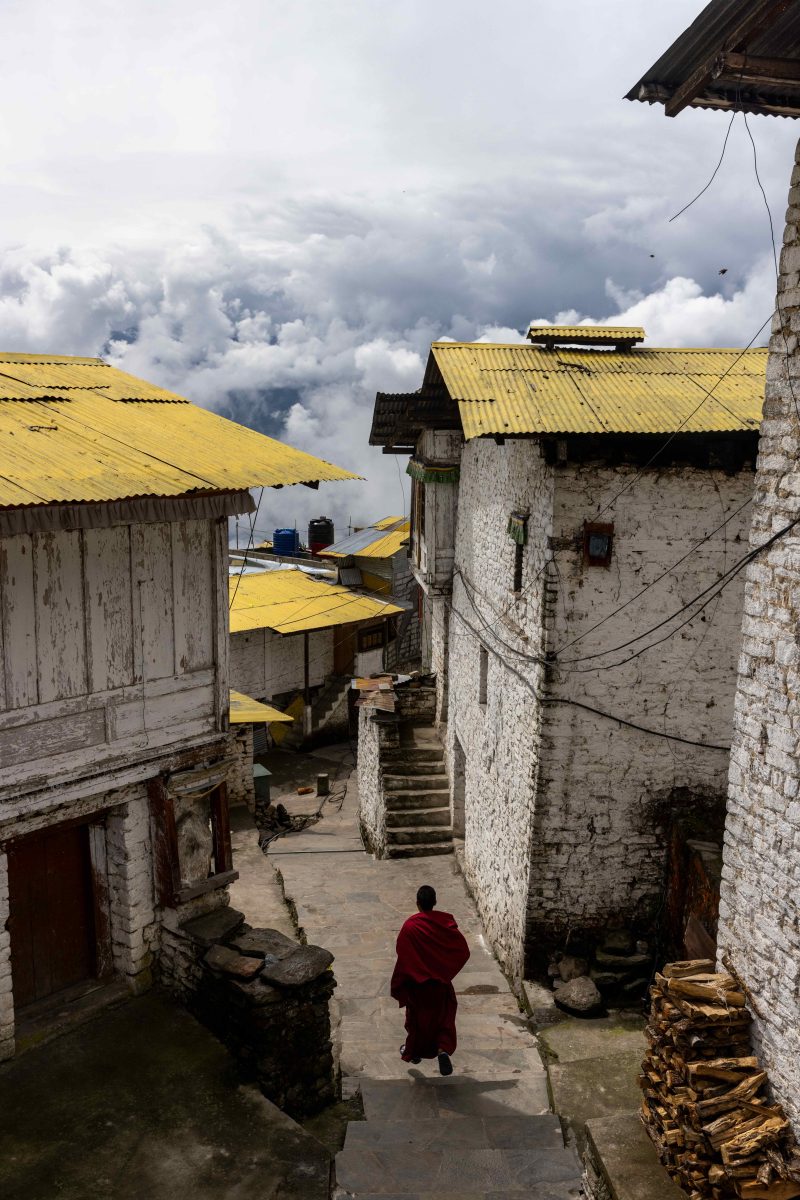
Nehru’s severest critics argue that it was his refusal to negotiate over the dubiously drawn borders bequeathed by the British Raj that pushed India into a disastrous war. The scars of that conflict mean that, despite the bellicose posturings of Modi and his right-hand man Amit Shah, the government has little desire to take on a militarily and economically superior China. But for at least three years now, both countries have been staring each other down. And there is little indication of when they will choose to return to the dormant, if unresolved, status that characterized their border relations for half a century after 1962.
Sanjib Baruah, a political studies professor at Bard College, told me that “relations between India and China have deteriorated during the last decade primarily because of global strategic realignments.” As it always has, China sees its relationship to India only in the context of wider Chinese geopolitical ambition. President Xi Jinping, Baruah said, has expressed his belief that the U.S. and its allies are conspiring to contain further Chinese advancement. “This is the context,” Baruah added, “in which China sees India’s growing closeness with the U.S. as a threat.”
In February, two U.S. senators introduced a bipartisan resolution in the Senate “reaffirming the United States’ recognition of the Indian state of Arunachal Pradesh as an integral part of the Republic of India.” The resolution noted that the U.S. “recognizes the McMahon Line as the international boundary between the People’s Republic of China and the Indian state of Arunachal Pradesh.” China, said Baruah, the Bard professor, “probably sees the resolution as a provocation.”
The history of the McMahon Line, with the haphazard way it came to be an international border between India and China and the renewed fervor with which both nations claim Arunachal Pradesh’s status to be non-negotiable, is evocative of Benedict Anderson’s line in his seminal work, “Imagined Communities.” It is, Anderson wrote, “the magic of nationalism to turn chance into destiny.” To see Tawang as an integral part of either India or China is a willful act of magical thinking.
Before I left Tawang, I spoke again to Jambey Wangdi. It seemed he too had chance and destiny on his mind. “If the problem of Tibet could be solved,” he said, “whether it’s autonomy or a free Tibet…” He trailed off. Wangdi left the tantalizing prospect of a free Tibet unexplored. He didn’t speculate what that might mean for Tawang, which is closely connected to Tibet through their shared Buddhism. In 1683, the sixth Dalai Lama was born in Tawang, one of only two to have been born outside the precincts of Tibet proper. So even then Tawang’s geographical status, if not its cultural identity, was liminal — a peripheral place between other, bigger, more significant places.
It feels like a place that was designed to provoke arguments. Tawang’s value to both India and China is symbolic: It’s about geopolitics, strategy and national self-image. As a consequence, Wangdi pointed out, “the amount of money spent on the military on the border is enormous.” If you have a good neighbor, he said, “you can spend that money on health and education.” If you have a good neighbor, he laughed, “you can get some sleep at night.”
The story you just read is a small piece of a complex and an ever-changing storyline that Coda covers relentlessly and with singular focus. But we can’t do it without your help. Show your support for journalism that stays on the story by becoming a member today. Coda Story is a 501(c)3 U.S. non-profit. Your contribution to Coda Story is tax deductible.
The Big Idea
Shifting Borders
-

When your body becomes the border
feature Erica Hellerstein
-

India and China draw a line in the snow
feature Shougat Dasgupta
-

How an EU-funded agency is working to keep migrants from reaching Europe
feature Zach Campbell and Lorenzo D'Agostino
-

Turkey uses journalists to silence critics in exile
feature Frankie Vetch





